"We have not searched for them all
[asteroids], we only know a small fraction of the ones that
exist, and... those particular ones are not going to hit any
time in the next 100 years or so, which is about as far as we
can reliably calculate the orbits, but the other 90 percent that
we haven't found yet could hit any time."
Clark Chapman
Planetary Science Institute, PBS
Nova "Doomsday Asteroid" 10/31/95
"A comet can have the hiccups, and those hiccups can change its
course in space. Scientists say comets that suffer hiccups are
those that emit bursts of gas, these bursts act like jets and
alter the comet's orbit."
Discovery "Impact: Could
It Happen?" 5/4/98
"Collisions can launch large asteroid chunks into unstable
orbits that move them into collision courses with our planet. In
some places, asteroids experience traffic jams. It's possible
some of these asteroids eventually will move onto an
Earth-collision trajectory."
William Bottke
Cornell U. astronomer, CNN News
6/28/00
"Computer models used to study numerous asteroid belt bodies…
lent support to the idea that the heated bodies experienced
altered orbits. Many of the fragments seem to have been swept
into narrow chaotic zones known as resonances, where tiny
gravitational kicks produced by nearby planets such as Mars,
Jupiter, or Saturn can push asteroids out of the asteroid belt."
Science Journal 11/23/01
"Let us say an [asteroid] would have been discovered... after
discovery, we would not know for quite some time (perhaps weeks,
months or years) whether or not the object would actually hit
the Earth. In fact, the impact probability might go up to 50%
before plunging to 0% [or vice versa].
Geoffrey Sommer
RAND - SpaceDaily.com 2/17/03
"The gravitational influence of the giant gas planets, like
Jupiter, or an impact by a comet, can knock these large rocks
out of their safe orbit."
About.com 9/2/03
"The largest asteroid ever known... Toutatis's orbit changes
slightly with each 4-year trip around the sun. 'Because of the
nature of the orbit, we cannot predict thousands of years into
the future for this object,' said Alan Harris, a senior research
scientist at the Space Science Institute… some rumors have
suggested the asteroid's forecasted course might be off by
enough to cause a collision with Earth… 'The actual path
of it has indeed varied a bit from the original calculated,'
Harris said."
Space.com 9/28/04
"Orbits change with time because of gravitational tugs by the
Sun and planets, among other factors... the 323-day orbit of
asteroid 2004 MN4 lies mostly within the orbit of Earth.
Scientists cannot say that the asteroid will never hit Earth."
Space.com 12/27/04
"If an object is on a collision course with Earth, due to hit in
say a half a century or a century... we won't really know that
until we get within perhaps a decade of the collision."
Steve Ostro
Radio Astronomer, NASA JPL -
Science of the Impossible - TLC 7/12/98
IN OTHER WORDS, THE ABILITY
OF SCIENTISTS
TO PREDICT THE PATH OF ANY SPACE
ROCK
IS EXTREMELY LIMITED.
COMETS AND ASTEROIDS ALTER THEIR
PATHS AT RANDOM
IN RESPONSE TO MANY FORCES IN SPACE.
240-250 Million B.C.E.
"Two hundred and forty million
years ago 80 percent of life on Earth may have been wiped
out by asteroids... there may have been five events that may
have occurred within as brief a period of time as four
hours...[scientists] studied impact craters that seemed
unrelated on a modern map, but when you turn back the clock
200 million years to where the continents were before they
drifted to their current positions, the craters are almost
in a straight line... indicating that the body that collided
with Earth came in in chunks - bang, bang, bang..."
- ABC News - May 7,
1998
The journal Science [Feb. 23, 2001]
reported conclusive evidence that an asteroid smashed into Earth
250 million years ago and likely launched the age of the
dinosaurs.
The impact disaster wiped out 70
percent of land vertebrates and 90 percent of marine animals.
The research performed by NASA, the National Science Foundation,
and three leading universities, revealed a type of carbon
structures called fullerenes in 251 million year old geological
samples taken from Japan and China.
On June 1, 2006 scientists, using satellite data, discovered the
300-mile-wide crater buried more than a mile beneath the East
Antarctic Ice Sheet in what's known as the Wilkes Land region of
Antarctica.
65 Million B.C.E.
In 1979 physicist Luis Alvarez, his son, geologist Walter
Alvarez, and nuclear chemists Frank Asaro and Helen V. Michael
from the University of California, Berkeley, began to publish
their research regarding "Extraterrestrial cause for the
Cretaceous-Tertiary extinction."
In June 1980 the journal Science
published the Alverez team's groundbreaking report titled,
Extraterrestrial Cause for the Cretaceous-Tertiary Extinction.
The team had discovered unusually high concentrations of
iridium, an element that's rare on the Earth but common in
meteorites. From the amount and distribution of iridium present
in the 65 million year old "iridium layer", the Alvarez team
estimated that an asteroid about 5 milies wide (10-14
kilometers) must have collided with the Earth.
This iridium layer has been found
worldwide at 100 different sites.
In 1981, exploring for oil reserves in Yucatan, Mexico, Penfield
and Camargo recognized that the gravity and magnetic anomalies
centered on the village of Chicxulub, at the tip of the Yucatan
peninsula in Mexico, resemble those identified at large impact
structures. But it was only in 1991, that Hildebrand et al.,
proposed that the long sought impact crater lied buried under
1000 m of Cenozoic sediments at the tip fo the Yucatan
peninsula.
During the following years, the
crater origin of the structure was demonstrated by geophysical
and lithological studies and its age determined by radiometric
dating (Swisher et al. 1992; Sharpton et al. 1993).
The
northwestern part of the crater lies offshore of the Yucatan
peninsula. Onshore the crater rim is marked by
a line of cenote (Pope et al, 1996).
35 Million B.C.E.
Thirty five million years ago, a 5 km-wide asteroid ploughed
into what is now Chesapeake Bay, in the US, leaving an 80 km
crater.
Undetermined Date:
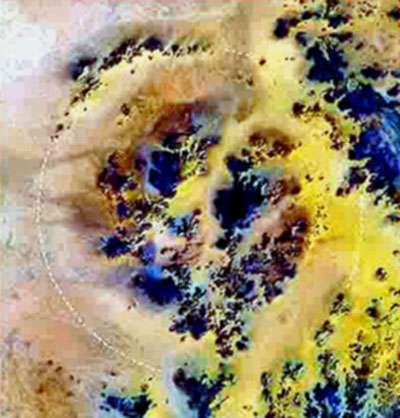
Kebria Crater in Egypt
On March 3, "2006" Space.com reports,
"Huge Crater Found in Egypt
- Scientists have discovered a huge crater in the
Saharan desert, the largest one ever found there. The
crater is about 19 miles (31 kilometers) wide, more than
twice as big as the next largest Saharan crater known.
It utterly dwarfs Meteor Crater in Arizona, which is
about three-fourths of a mile (1.2 kilometers) in
diameter.
In fact, the newfound
crater, in Egypt, was likely carved by a space rock that
was itself roughly 0.75 miles wide in an event that
would have been quite a shock, destroying everything for
hundreds of miles. The crater was discovered in
satellite images by Boston University researchers Farouk
El-Baz and Eman Ghoneim.
El-Baz named the crater 'Kebira,'
which means 'large' in Arabic and also relates to its
location on the northern tip of the Gilf Kebir region in
southwestern Egypt…
The crater has two rings, a
common configuration. Over time, it has been eroded by
wind and water to make it unrecognizable to the
untrained eye. The impact that carved Kebira might have
created an extensive field of yellow-green silica
fragments, known as desert glass and found on the
surface between the giant dunes of the Great Sand Sea in
southwestern Egypt."
"The Zodiac Glass gleams through
the sky, it could happen soon… If you revert back in
time, there's Egypt. It's very dusty now, but it used to be
green. I had a vision and it told me to go there. I'm always
having visions and I know that it's building up to something
really major."
- Jimi
17 Million B.C.E.
Two asteroids crash into the Atlantic Ocean 150 km (93 miles)
south of the Azores. The larger one left a crater 6 km (3.7
miles) wide, 2 km (1.2 miles) under the ocean surface. The
craters were discovered in 2008.
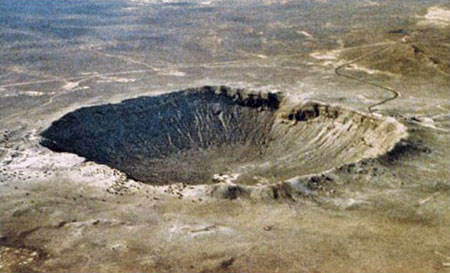
Meteor Crater, AZ
48,000 B.C.E.
A meteor about 50 meters (54 yards) across impacts the desert
near what is now Flagstaff, Arizona, leaving a crater about
1,200 m (4,000 ft) in diameter, some 170 m deep (570 ft),
10,900 B.C.E.
In June 2007 University of South Carolina News reported: Comet
Theory Collides with Clovis Research, May Explain Disappearance
of Ancient People:
"A theory put forth by a group
of 25 geo-scientists suggests that a massive comet exploded
over Canada, possibly wiping out both beast and man around
12,900 years ago, and pushing the earth into another ice
age.
Archaeologists have long known that the great beasts of
the age - the wooly mammoth and mastodon - suddenly
disappeared around the same time period (12,900 - 12, 800
years), but little was known about their demise.
The notion that a comet collided
with Earth and caused these events was farfetched until
recently, when the group of scientists began looking for
evidence of a comet impact, which they call the Younger -
Dryas Event.
"They turned to University of South Carolina archaeologist
Dr. Albert Goodyear and the pristine Clovis site of Topper.
In 2005, Arizona geophysicist
Dr. Allen West and his team traveled to Topper in hopes of
finding concentrations of iridium, an extra-terrestrial
element found in comets, in the layer of Clovis-era
sediment.
'They found iridium and
plenty of it,' said Goodyear. 'The high concentrations
were much higher than you would normally see in the
background of the earth's crust. That tends to be an
indicator of a terrestrial impact from outer space.'
The researchers also found high
iridium concentrations at six other Clovis sites throughout
North America, as well as in and along the rims of the
Carolina Bays, the elliptically shaped depressions that are
home to an array of flora and fauna along South Carolina's
coast.
The Younger-Dryas Event suggests
that a large comet exploded above Canada, creating a storm
of fiery fragments that rained over North America. The
fragments could have easily killed the giant mammals of the
day, as well as Clovis man.
"'No one has ever had a really good explanation for the
disappearance of mammoth and mastodon,' Goodyear said. 'The
archaeological community is waking up to the Younger-Dryas
Event.' The comet theory dominated the recent annual
meetings of the American Geophysical Union held in Mexico.
Goodyear's Clovis-Redstone point study and West's research
on the comet were featured at the AGU meetings and by the
journal, Nature.
The comet will be the subject of
documentaries featured on the
National Geographic Channel
and NOVA television late this fall [2007] and in early
2008."
8498 B.C.E.
German physicist, Otto Muck, analyzed the elaborate calendar of
ancient Mayan Indians and established that its purpose is to
commemorate the date and time of impact of an asteroid that
crashed into the Atlantic Ocean more than ten thousand years
ago.
In his book, The Secret of Atlantis, Muck concludes that
the impact coincided with a conjunction of the Sun, Moon, and
Venus.
This triple conjunction enabled a
calculation of orbits to find the exact moment of impact: 20:00
hours local time on June 5, 8498 B.C.E. From this cataclysmic
moment over 10,500 years ago, marked by a triple conjunction,
ancient Mayans counted the days and years of their calendar.
Muck concludes that the impact and tidal waves produced the
story of Atlantis, as well as the biblical flood of Noah, and
the legend of Gilgamesh.
Other researchers contend that a comet or asteroid that crashed
into the Indian Ocean south of Madagascar 4800 years ago (see
below) is a better candidate as the souce of the Noah/Gilgamesh
legend, because Hebrew writings, the souce of the Noah story,
date back only to the 6th century B.C.E.
But then in January
2010 LiveScience.com reported that,
"scientists have discovered the
earliest known Hebrew writing - an inscription dating from
the 10th century B.C.E., during the period of King David's
reign. The breakthrough could mean that portions of the
Bible were written centuries earlier than previously
thought…
The writing, dug up during
[2009] excavations at Khirbet Qeiyafa, near Israel's Elah
Valley, indicates that the Kingdom of Israel already existed
in the 10th century B.C.E. and that at least some of the
biblical texts were written hundreds of years before the
dates presented in current research."
This scenario supports Muck's
assertion that a fully developed Hebrew writing society dating
back 12,000 years would likely have recorded a massive tsunami
in the region that occurred 10,500 years ago, a tsunami that we
know today as "Noah's flood."
Until the ancient writings from Khirbet Qeiyafa were unearthed
in 2009, it appeared that the story of the Noah/Gilgamesh flood
likely resulted from a more recent impact tsunami near
Madagascar 4800 years ago…
2800 B.C.E.
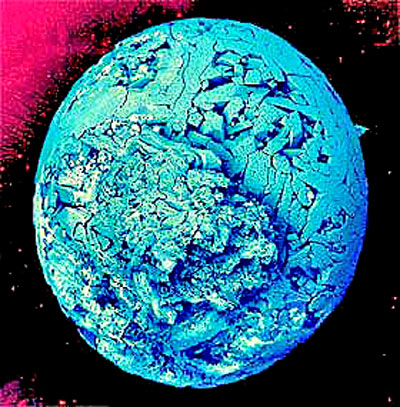
Microscopic "Spherule"
Fingerprint of
Asteroid-Tsunami
The New York Times News Service
(Nov. 14, 2006) reports,
"This tiny spherule [see right] is
a once-vaporized or melted fragment of microejecta resulting
from an extraterrestrial impact into the Indian Ocean about
4,800 years ago. Some scientists believe the hit, by either
a meteor or asteroid, produced a tsunami at least 600 feet
high…
Madagascar provides the smoking
gun for geologically recent impacts… tiny fossils from the
ocean floor, sprinkled throughout [with] splashes of iron,
nickel and chrome fused to the fossils. When a chondritic
meteor, the most common kind, vaporizes upon impact in the
ocean, those three metals are formed in the same relative
proportions as seen in the microfossils… [that] melded with
the condensing metals as both were lofted up out of the sea…
About 900 miles southeast from
Madagascar, in deep ocean, is the Burckle Crater… cores from
the area contain high levels of nickel and magnetic
components associated with impact ejecta. Holocene Impact
Working Group… experts in geology, geophysics,
geomorphology, tsunamis, tree rings, soil science and
archaeology… say that astronomers simply have not known how
or where to look for evidence of [asteroid] impacts.
They say that once they started
looking, the evidence was obvious…

Classic Chevron Insignias
"At the southern end of
Madagascar lie… enormous wedge-shaped sediment deposits,
called chevrons, that are composed of material from the
ocean floor… the chevron deposits contain deep ocean
microfossils that are fused with a medley of metals
typically formed by cosmic impacts.
And all of them point in
the same direction - toward the middle of the Indian Ocean
where a newly discovered crater, 18 miles in diameter, lies
12,500 feet below the surface.
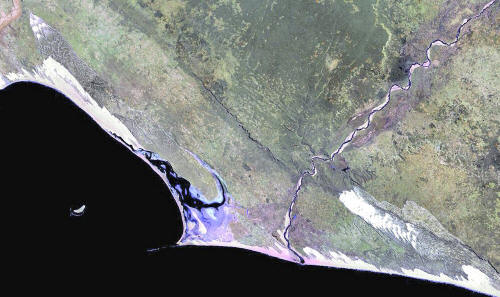
Fenambosy Chevrons in Madagascar
Chevron
points directly at 4800 yrs. old impact crater at bottom
of Indian Ocean
A large asteroid or comet, the
kind that could kill a quarter of the world's population,
smashed into the Indian Ocean 4,800 years ago [2800 BCE],
producing a tsunami at least 600 feet high, about 13 times
as big as the one that inundated Indonesia [Dec. 2004
tsunami]… astronomers have not known to look for evidence of
such impacts during the past 10,000 years (known as the
Holocene epoch) along the world's shorelines and in the deep
ocean.
They say the evidence is strong
enough to overturn current estimates of how often the Earth
suffers a violent impact… Instead of once in 500,000 to 1
million years, as astronomers now calculate, catastrophic
impacts could happen every few thousand years…
"Surveys show that as many as 185 large asteroids or comets
have hit the Earth [but] most of the craters are on land.
'No one has spent much time looking for craters in the deep
ocean,' said David Morrison, a leading authority on
asteroids and comets at the NASA Ames Research Center in
Mountain View."
800 C.E.
New York Times - Nov. 14, 2006:
"Ted Bryant, a geomorphologist
at the University of Wollongong in New South Wales,
Australia, was the first person to recognize the palm prints
of mega-tsunamis… Deposits from mega-tsunamis contain
unusual rocks with marine oyster shells… [he] started… to
search around the globe for chevrons, which [he] interpret
as evidence of past giant tsunamis.
Scores of such sites have turned
up in Australia, Africa, Europe and the United States,
including the Hudson River Valley and Long Island… Bryant
identified two chevrons found more than four miles inland
near Carpentaria in north-central Australia. Both point
north… Searching the shallow water north of the two
chevrons, Dallas Abbott [scientist] found two craters. 'We
think these two craters are 1,200 years old,' Abbott said.
The chevrons are well preserved
and date to about the same time. Abbott and her colleagues
have located chevrons in the Caribbean, Scotland, Vietnam
and North Korea, and several in the North Sea. Heather Hill
State Park on Long Island has a chevron whose front edge
points to a crater in Long Island Sound, Abbott said.
There is another, very faint
chevron in Connecticut, and it points in a different
direction."
536 C.E.
Restricted tree ring growth across world forests after 536 C.E.
is among evidence scientists provide to prove that an asteroid
collided with Earth and the result was the Dark Ages.
Astronomical records in Europe
coincide with simultaneous records in China which report impact
winter conditions that enveloped the world for 18 months. The
space rock's entry into the atmosphere gave rise to folk tales
of dragons - long tailed, fire breathing lion's heads speeding
through the sky.
The comet or asteroid exploded in
the atmosphere, creating a dense cloud that encircled the Earth
and shut down photosynthesis. Tree ring records worldwide record
the event.
October 8, 1871
On the night of October 8, 1871 Peshtigo, a booming town of 1700
people was wiped out of existence in the greatest forest fire
disaster in American history.
Loss of life, and even property, in
the great fire occurring the same night in Chicago, did not
match the death toll and destruction visited on Peshtigo in
Northeast Wisconsin.
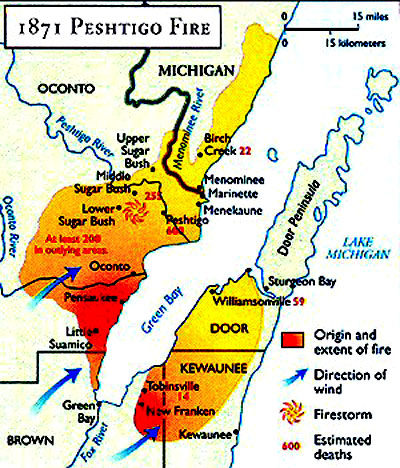
They Need Us To Think
"Mrs. O'Leary's COW" Killed Thousands
"The reason no one can explain these great fires is that no
one knew to look to the heavens," explains scientist Randall
Carlson, "But recent tests have shown that a comet nucleus
only a hundred yards in diameter exploding 20 miles up in
the atmosphere can set a large pine forest on fire. This is
the only explanation that can account for the simultaneous
outbreak of massive forest fires all over the mid west on
October 8, 1871."
In fact astronomers at that time were tracking the dying
comet Viala whose orbit was dangerously close to Earth. Some
scientists have suggested that fragments falling from the
comet may have ignited not only the Chicago fire, but the
fires in neighboring states as well. The most deadly fire
that night was not in Chicago, but in the small town of
Peshtigo. Twelve hundred people died there in the worst fire
in American history. A mass grave commemorates the remains
of victims burned beyond recognition."
Robert Couvillion is the president of the Peshtigo
Historical Society. The stories he has preserved are of a
fire unlike any other: "Fire is not unusual in this
territory, but on this particular night, this was a fire
like nobody had ever seen. It was 7 or 8 o'clock at night
when it became dark and they could see this glow in the
western sky.
It was like a muddled thunder
that never ceased, it just kept growing louder and louder.
Trees were being uprooted and roofs were coming off of the
homes, chimneys were crashing to the ground. Everything was
moving horizontally. It was like the heaviest snow storm
you've ever seen, only it contained the burning embers and
the ashes and the red hot sand and the dirt that was picked
up. When they decided it was time to go to the river,
already it was too late."
Before they could run, a firestorm blasted them off their
feet. Clothing and hair combusted spontaneously. The air
itself seemed to be on fire.
"Eyewitnesses described that the very sky itself was on fire
as far as the eye could into space," said Randall Carlson.
"Eyewitnesses described fireball and meteor-like phenomena
falling from the sky just prior to the outbreak of the fire.
In the aftermath they described whole forests of great maple
trees uprooted and laid flat like new mown hay. This is
strikingly suggestive of the forests knocked flat
at
Tunguska (Russian meteor impact site, June 30, 1908).
While
no one was killed at Tunguska, twelve hundred people lost
their lives at Peshtigo."
- Fire In the Sky, TBS 3/23/97
June 30, 1908
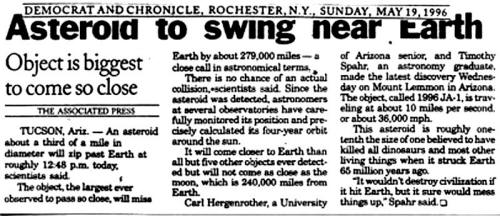
Tunguska Event
The Taiga meteorite impacts the Tunguska River in Siberia. While
the 1908 destruction in Siberia is well known, and repeatedly
cited in countless reports about impact hazards, two other,
more recent, but
similar, impacts that happened in South America
in the 1930s continue to be ignored by media as if they never
occurred (in order to play down and artificially reduce, in our
minds, the chance of another impact)...
August 13, 1930
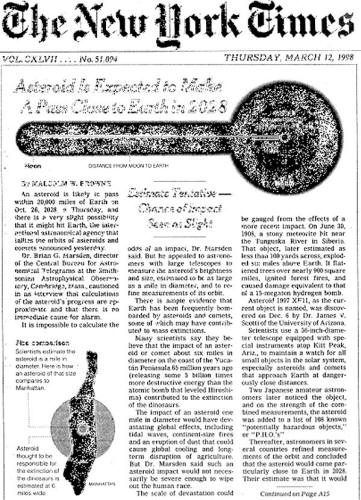
Rio Curaca Event
A massive asteroid explodes over western Brazil and is reported
in South American newspapers.
The explosion happened over
Amazonia, near the Brazil-Peru border and is described in the
papal newspaper L'Osservatore Romano, the report being derived
from Catholic missionaries working in Amazonia. That report, in
Italian, was used as the basis of a front-page story in the
London newspaper The Daily Herald, which was published on March
6, 1931.
The locality of the explosion gives it it's name:
The
Rio Curaca Event, close to the border between Brazil and Peru.
MENACE OF METEORS LIKE HUGE BOMBS FROM SPACE
HURRICANE OF FLAME
"Another colossal bombardment of the Earth from outer space has
just been revealed. Three great meteors, falling in Brazil,
fired and depopulated hundreds of miles of jungle. The Brazilian
meteors are reported (says the Central News) by Father Fidello
of Aviano, writing from San Paulo de Alivencia in the state of
Amazonas, to the papal newspaper, Osservatore Romano.
Terrific
heat was engendered. Immediately after they struck the ground
the whole forest was ablaze. The fire continued uninterrupted
for some months, depopulating a large area. The fall of the
meteors was preceded by remarkable atmospheric disturbances.
Three great explosions were heard and the Earth trembled."
The Daily Herald - March 6, 1931
December 11, 1935
Marudi Mountain Event:
Three asteroids exploded in tremendous fireballs a mile above
the jungle floor of Brazil and British Guyana close to Marudi
Mountain, igniting a ground fire that destroyed over 800 square
miles of rain forest.
"In the magazine The Sky (forerunner of Sky & Telescope) of
September 1939, a report from Serge Korff of the Bartol Research
Foundation, Franklin Institute (Delaware, USA) was printed.
Korff was in the area - the Rupununi region of British Guyana -
a couple of months [after impact]. Korff's description suggested
that the region of devastation might be greater than that
involved in
the Tunguska [Siberia, June 1908] event.
Korff
obtained several local reports, the best being from a Scottish
gold miner, Godfrey Davidson, who reported having been woken by
the explosion, with pots and pans being dislodged in his
kitchen, and seeing a luminous residual trail in the sky. A
short while later, whilst prospecting, he came across a
devastated region of the jungle he estimated to be about five by
ten miles (8 by 16 kilometers), with the trees all seeming to
have been pushed over.
"On Korff's suggestion, a message was sent to William H. Holden,
who in 1937 was in the general region with the Terry-Holden
expedition of the American Museum of Natural History. That group
hiked to the top of Marudi Mountain in November 1937 and
reported seeing an area some miles across where the trees had
been broken off about 25 feet above their bases. Holden believed
the devastation was due to an atmospheric explosion of cosmic
origin.
"An explorer and author, Desmond Holdridge, also visited the
region in the late 1930's and confirmed the suspicion that a
comet or asteroid detonation was responsible. Holdridge reported
eye-witness accounts in accord with a large meteoroid/small
asteroid entry, with a body passing overhead accompanied by a
terrific roar (presumably electrophonic effects), later
concussions, and the sky being lit up like daylight.
"And a local aircraft operator, Art Williams, reported seeing an
area of forest more than twnety miles (32 kilometers) in extent
which had been destroyed, and he later stated that the shattered
jungle was elongated rather than circular, as had occurred at
Tunguska."
Duncan Steel
WGN, Journal for International Meteor Organization
Dec. 1995
February 1936
A large asteroid named Adonis passed within 186,000 miles of
Earth. Had it hit it would've wrought destruction equal to
several nuclear explosions.
September 1985
An asteroid the size of
several football fields comes within 1.5 the distance of the
Moon from the Earth. This incident was referred to in January
2008 when another similar asteroid, 2007 TU24, was discovered
heading for a similar near miss of Earth.
March 22, 1989
An asteroid came within 400,000 miles of Earth, and was within 6
hours of striking the Earth, but was not detected until later.
Other asteroids have come even closer, one would have hit the
Earth if it had come just 4 hours sooner.
Asteroids - Deadly Impact
National Geographic, NBC 2/26/97
"In 1989 we had an asteroid pass us at only 690,000 miles
away... and in 1991 the Earth came perilously close to yet
another encounter with an asteroid. This asteroid passed the
Earth at a distance of only 106,000 miles...
These asteroids
just barely missed us. Had they been at just a slightly
different path, or been traveling at just a tiny different
speed, the human race and much of the life on our planet would
be gone now...
These two most recent close passes by asteroids
were discovered only a couple of months before they would have
hit."
Practical Guide to the Universe, TLC 2/95
December 6, 1994
The closest near collision in recent decades takes place when
asteroid 1994 XL1 passes within 65,000 miles (105,000 km) of
Earth.
1994
Another asteroid explodes over the Pacific Ocean near
Micronesia. It blew up in the atmosphere with a force five times
the size of the atomic bomb dropped on Hiroshima.
March 26,
1996
Hyakutake comet makes its closest approach to Earth as ABC World
News concludes with a report about our unpreparedness for
fending off a Rock aimed at our planet.
Astronomer Neil Tyson of
the Hayden Planetarium sums up,
"I know of no way that we can
stop it."
May 19, 1996
Asteroid JA-1, a third of a mile wide, passes within 279,000
miles of Earth, a near miss.
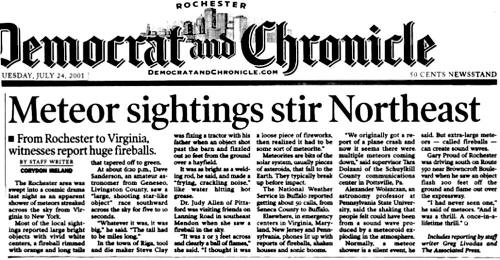
JA-1 was spotted just four days
before it passed.
"A fairly sizeable asteroid went across the
sky in less than five days," reported an official at the Jet
Propulsion Laboratory. "We would not have had time to do
anything that would have diverted this object."
March 22, 1997
Astronomy magazine's cover story is headlined,
"Comet Hale-Bopp
Takes Center Stage... this space rock... is three times the size
of an average comet... On March 22, 1997 Comet Hale-Bopp is in
conjunction with the Sun... It is also nearest the Earth on this
date... a total solar eclipse is visible across Mongolia... the
appearance of a comet during an eclipse is extremely rare; less
than half a dozen 'eclipse comets' have been seen throughout
recorded history."
March 11, 1998
The first reports about asteroid 1997 XF11 airs on the Evening
News and a rising tide of anxiety consumes world media. Humanity
awakes to a black Thursday on March 12 and stares at blaring
headlines:
"Asteroid Heads Towards Earth!"
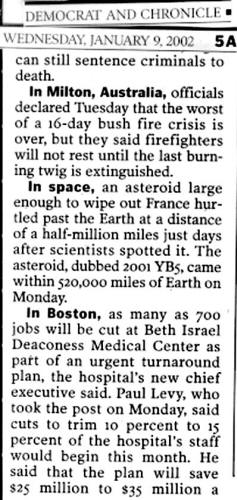
August 6, 1998
Beneath a photo of asteroid 1980-H CNN reports,
“U.S. space
scientists said Wednesday they have discovered two real
asteroids heading in Earth's direction… these asteroids are not
expected to come anywhere near Earth's orbit for at least
several decades.
The two asteroids, each of them at least one
mile across, have been classified as ‘potentially hazardous
objects’ by the NASA Jet Propulsion Laboratory in Pasadena,
California, because they are large enough to cause global
effects if they hit Earth… the asteroids passed within 2 million
miles of Earth during their last orbit.“
May 19, 1999
Exactly 3 years after asteroid 1996 JA-1 nearly collided with
Earth, BBC News reports,
"A large asteroid could miss the Earth
by only 38,000 kilometers (20,000 miles) in 2027, according to
new astronomical observations. This is an extremely close shave
- the Moon orbits 10 times further from Earth… the Earth's
gravity could perturb the asteroid's path, possibly leading to
an impact in 2039.
The near-miss trajectory of a
newly-discovered asteroid, called 1999 AN10, was announced in
April. Now, the observational data of Australian astronomer F. Zoltowski allows calculations of just how close the asteroid may
come to Earth. Astronomers at the Minor Planet Center at the US
Smithsonian Astrophysical Observatory used Zoltowski's work to
work out an estimated approach distance for AN10…
The fly-by
will occur on Aug. 7, 2027. But the closest distance that AN10
could come to the Earth on that day is only 38,000km…
calculations confirm the initial speculation that the asteroid
might approach within the Earth's sphere of gravitational
influence. It could therefore be perturbed in such a way that it
might impact some years later.
"Dr Benny Peiser of Liverpool John Moore's University in England
says that the chaotic behavior of this asteroid makes it
practically impossible to predict all possible approaches for
more than a few decades after any close encounter. He says the
orbit will remain dangerously close to the orbit of the Earth
for about 600 years…
If it did strike, it would cause
continent-wide devastation and alter the Earth's climate."
December 5, 1999
Millions of Americans witness a giant meteorite Rock grazing the
Earth's atmosphere, cutting a flaming streak over Alabama and
several neighboring states.
January 18, 2000
With the force of multiple nuclear warheads, a giant meteor
explodes over Tagish Lake in British Columbia near Alaska.
February 7, 2000
The University of Pisa issues a "scientifically urgent" warning
about the trajectory of Asteroid 2000 BF19, aimed to arrive near
Earth in 2022.
Astronomer Andrea Milani breaks the code of
silence engaged by all professional star gazers gagged by the
U.S. government's decree to keep secret all discoveries of Earth
threatening rocks from space. Milani is immediately besieged by
a swarm of government scientists trained to "creatively
recalculate" the trajectory of rocks like 2000 BF19.
MSNBC picks
up the banner with reports that cite astronomers who have been,
"gathering additional data about the orbits of asteroids so that
they could eventually be excluded as a threat... Two years ago,
the first such asteroid alert caused quite a stir," notes MSNBC,
"more recent alerts have been greeted much more calmly."
More
"calmly" because the news never really surfaces for the public
to consider in a dominator controlled media. MSNBC boasts that,
for mile wide asteroid 1997 XF11, aimed to rendezvous with Earth
in 2028, concerns were "erased within days."
Microsoft Network
reveals that in April, June, and October of 1999, four more
asteroids were discovered to be headed towards Earth, but, after
government officials creatively recalculated trajectories for
these rocks, concerns were "erased within days."
July 10, 2000
BBC News reports,
"Earth-Approaching Space Rock Found By
Accident - The space rock was found by accident on 2 July by
astronomer Leonard Amburgey of Fitchburg, Massachusetts. He
typed in the wrong celestial co-ordinates into his
computer-controlled telescope and stumbled across the [1.8 mile]
sized object.
The asteroid has been given the temporary
designation 2000 NM by the Minor Planet Center in Cambridge,
Massachusetts. Astronomers say this is the brightest near-Earth
asteroid to be discovered in the past year. However, they are
concerned that it was found by accident and was missed by the
half dozen professional minor-planet surveys currently in
operation.
At the moment, it is about [13 million miles] from
Earth. It crosses inside the Earth's orbit at the end of July."
September 1, 2000
Asteroid 2000 QW7, half a kilometer wide, races past Earth at
about twelve times the distance of the Moon.
The "Near-Earth
Object" was discovered last weekend on August 26, 2000, with
NASA/JPL's Near Earth Asteroid Tracking (NEAT) system. QW7
caught the attention of astronomers because it was fast-moving
and unusually bright.
At 13th magnitude, amateur astronomers
could easily spot the Rock through 8-inch telescopes. 2000 QW7
falls into a category of Near-Earth Objects (NEOs) called
Potentially Hazardous Asteroids (PHAs).
November 4, 2000
Frontpage headlines worldwide again report that an asteroid is
on course to cross paths with Earth. A rock the size of an
office building, and named 2000 SG344, is due to arrive on
September 21, 2030, with a 1 in 500 chance of impact. Scientists
announce that if it hits the Earth it will release 100 times the
energy of the atomic bomb dropped on Hiroshima.
For three days a
group of international astronomers analyzed data on the rock
before making today's announcement.
"This is the highest
probability of impact that we have ever calculated for an
object," said Paul Chodas, project engineer for the Near-Earth
Object Program.
July 24, 2001
Front page news in Rochester reports a massive space rock that
streaked over our city at 6:18 p.m. the evening before (notice
the multiples of 3 in the time: 6:18 - the book Rock Prophecy
contains a chapter titled "Multiples of Three" which chronicles
the repeated incidents in the Hendrix legacy of numbers that are
multiples of 3.)
At right is an amazing photo of the space rock that buzzed over
our city just hours prior to the publication of our ad that
mentions the "Hendrix/asteroid/Microsoft connection" - in
preparation for the first show from the band that is spreads
word of Rock Prophecy.
October 8, 2001
Space-Frontier.org reports,
"an asteroid thought to be between
50 and 100 meters in diameter zoomed by our planet at little
more than twice the distance to the Moon - a whisker by the
standards of our solar system's size. The object was first
detected just two days prior. Its path was determined only the
day before the close encounter."
Incredibly, NO mainstream media covered this event. It was
reported only after another big asteroid wizzed by even closer
on January 7, 2002 (next)...
January 7, 2002
"Earth Escapes Brush With Killer Asteroid" is the CNN headline
today.
"The Near-Earth Object '2001 YB5' brightened enough for
even simple telescopes to spot just before it raced past our
planet on Monday. Many scientists classify it as a close call.
'The impact would be quite tremendous,' said Benny Peiser of the
Royal Astronomical Society in Great Britain...
In the year 2027,
an asteroid between one kilometer and a mile in length is
expected pass even closer... later on, either asteroid could
pose risks to the planet, along with countless rocks lurking in
the shadows that have yet to be identified, astronomers warn...
What particularly troubles Peiser is that scientists only first
spotted 2001 YB5 in late December. What if it had been heading
on a collision course? 'That's not enough time for any
initiatives for deflection.
If we had 20 or 30 years' time, then
we could develop a technology to deflect an object. With our
current lacked of preparedness, we are helpless,' he said."
And as if this isn't enough, Mitch Battros of ECTV continues,
"As reported by my colleague David Whitehouse of BBC, an
asteroid discovered just a month ago is making a close approach
to the Earth. The name of this NEA (Near-Earth Asteroid) is
'2001 YB5'… Astronomers say that its proximity reminds us just
how many objects there are in space that could strike our planet
with devastating consequences.
Moving closer to the Sun, the
asteroid is passing by at less than three times the Moon's
distance from us - just 830,000 kilometers (510,000 miles) away
on 7 January, which is close in cosmic terms. It is thought to
be 300 meters in size - large enough to wipe out an entire
country if it struck the Earth.
"2001 YB5 was discovered in early December by the NEAT
(Near-Earth Asteroid Tracking) survey telescope observing from
Mount Palomar in California... It circles the Sun every 1,321
days. Astronomers add that it is 'potentially hazardous,'
meaning there is a chance that it may strike the Earth sometime
in the future.
Such a close encounter is rare but not
unprecedented. However, the only other known object that will
come closer to the Earth is an asteroid called 1999 AN10, which
will pass a shade closer on 7 August, 2027."
This CNN report contained an actual picture of the asteroid.
The
rock was visible to millions of people on Earth, so there was no
way any government could suppress or whitewash and minimize the
threat of this event. Instead, the editors of all major media
simply reduced every mention of the asteroid into tiny little
blurbs buried deep inside newspapers. Here are typical examples
(see below:)
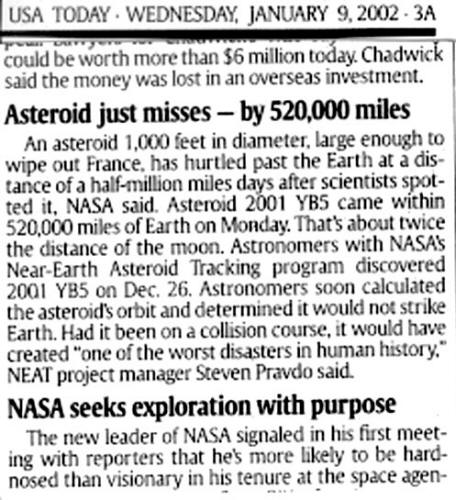
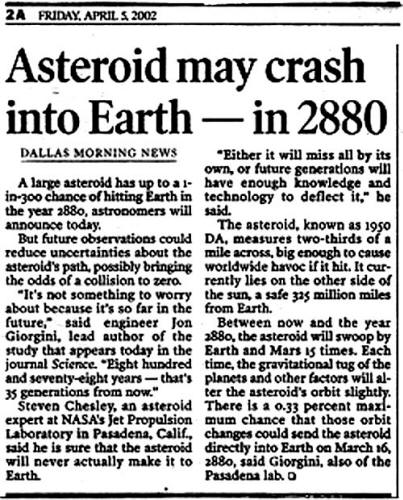
The article in USA Today is equally microscopic (see
above:)
This is an obvious ploy to minimize the event and train us to
shrug shoulders and ignore the threat.
March 8, 2002
On March 19, 2002, almost two weeks after Earth was nearly
pulverized by a rock named asteroid 2002 EM7, CNN finally
reports,
"A sizable asteroid zipped near our planet this month
without anyone noticing because it traveled through an
astronomical blind spot, scientists said.
The space boulder
passed Earth within 288,000 miles - or 1.2 times the distance to
the moon - on March 8, but since it came from the direction of
the sun, scientists did not observe it until four days later.
The object, slightly larger than one that flattened a vast
expanse of Siberia in 1908, was one of the 10 closest known
asteroids to approach Earth, astronomers said.
Asteroid 2002 EM7 took us by surprise. It is yet another
reminder of the general impact hazard we face,' said Benny
Peiser, a European scientist who monitors the threat of
Earth-asteroid collisions.
If it pierced the atmosphere, the
approximately 70-meter-long rock could have disintegrated and
unleashed the energy equivalent of a 4-megaton nuclear bomb,
researchers said.
'If it were over a populated area, like
Atlanta, it would have basically flattened it,' said Gareth
Williams, associate director of the International Astronomical
Union Minor Planet Center in Boston, Mass…
Astronomers maintain
that constant surveillance is necessary to identify more killer
rocks in our neighborhood and ensure that none take our planet
by surprise, in particular those traveling near the blinding
light of the sun.
'If one comes from the direction of the sun,
we're not going to see it,' Williams said. According to NASA's
Jet Propulsion Laboratory, 2002 EM7 could smack into Earth in
2093.
"If a comet should appear from behind the Sun, we might only
have a one or two year warning."
Carolyn Shoemaker
McNeil/Lehrer News Hour, PBS 7/23/94
This 2002 EM7 saga highlights the case of
The Incredible
Shrinking Asteroid News story.
Our managerial class of editors
(are they really all the same person?), for almost all media,
prevented any mention of this incident. In fact, it was only
after lengthy surfing through internet search engines that I
stumbled across this lone CNN report buried deep within CNN's
"Space" news archives.
Without question the men who control
media have ordered their lapdog editors to keep as many people
as possible in the dark about potential asteroid impacts.
April 4, 2002
World media again reports predictions of an asteroid (1950 DA)
aimed at Earth.
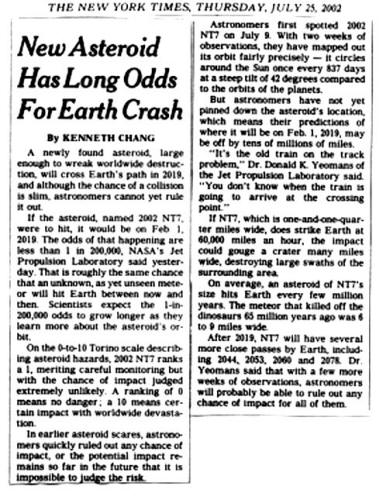
The significance of this report is that it's
another of the "approved" perspectives from NASA and government,
designed to persuade us that the threat is way off in the
future, out of sight/out of mind, and of little concern to
civilization today.
1) The rock aimed at Earth will not be "spotted" very much in
advance by the tiny network of astronomers and amateurs that
search the skies in our time.
2) Contrary to today's benign report, news of any asteroid that
is aimed to hit Earth within the next century will be concealed
by the men who control media. Any astronomer who tries to
announce an imminent impact will find our government creatively
re-calculating the rock's trajectory to "discredit" the
astronomer who breaks ranks and tries to communicate directly
with the public.
3) This report is aimed to portray asteroids in a
non-threatening way. Our ruling class wants us to remain in
denial, while we're manipulated into supporting the Defense
Agency's "anti-missile" system.
June 14, 2002
Asteroid 2002 MN nearly collides with Earth. All world media
suppresses this story until five days later when CNN finally
reports,
"An asteroid the size of a football field passed
extremely close to Earth last week but it remained undetected
until days later, according to astronomers. The space rock
missed our planet last week by only 75,000 miles (120,000 km),
about one-third the distance to the moon, making the near
collision one of the closest ever recorded.
Cruising at 6.2
miles (10 km) per second, the big boulder could have unleashed
some major firepower had it struck, according to the NEO (Near
Earth Objects) Information Center in Leicester, England.
The
destructive force might have been comparable to an asteroid or
comet that exploded over Siberia in 1908, which flattened 77
square miles (2,000 square km) of trees, according to the NEO…
The asteroid, designated 2002 MN, was first spotted on June 17
by scientists with the Lincoln Near Earth Asteroid Research
(LINEAR) project in Socorro, New Mexico, three days after it
gave the Earth a close shave."
This incident is the THIRD (known) near miss of Earth by
asteroids in the past six months.
July 24, 2002
ABC News announces,
"You might mark February 1, 2019 on your
calendar. That's the day scientists say a mile wide asteroid
could collide with the Earth, and the impact could destroy a
continent… They just discovered this asteroid and they'll know
more after observing it longer."
Notice the clincher at the end of this New York Times article
(see left),
"astronomers will probably be able to rule out any
chance of impact ."
This statement is the foregone conclusion that ALL modern
reports of asteroids are required to conform to.
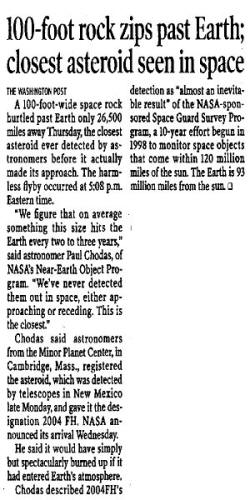
All astronomers
associated with NASA and the US Government are ordered to
"creatively re-calculate" the orbits of any asteroid or comet on
a collision course with Earth. The intent is to pacify the
public and nullify any cause for concern. Scientists are today
engaged in cooking the books, all news of space rocks is Enron-ed
& WorldCom-ed - with data skewed into fake happy endings.
The
interesting thing about news of 2002 NT7 is that it was leaked
to media from England before NASA had the chance to water down
the trajectory calculations. The astronomer who reported this
asteroid's path didn't conform with NASA's order to fudge the
numbers and "prove" that the rock is not a threat to Earth.
And notice the names given to June's "2002 MN" asteroid (see
above) and July's "2002 NT7" asteroid - are these references to
Microsoft Network (MN) and Windows NT (NT)? Certainly the witch
doctors at NASA who name these rocks are aware of Microsoft's
role in suppressing the Hendrix Rock Prophecy.
August 18, 2002
World media covers the approach of asteroid 2002 NY40 as it
passes within 330,000 miles of Earth, slightly farther than the
distance of the moon.
This half mile wide rock comes close
enough to be seen through small telescopes or binoculars. It is
unusual for an asteroid to be so bright. Don Yeomans, who
manages NASA'a Near-Earth Object Program at the Jet Propulsion
Laboratory in Pasadena, California, said, "Asteroids are hard to
see because they're mostly black like charcoal.
CNN reports,
"Scientists planned to 'ping' it with radio waves,
the radar observations can help determine whether the
asteroid... will pose a threat to Earth in the future."
October 3, 2002
The Associated Press reports,
"At least 30 times per year a
space rock slashes into the Earth's atmosphere and explodes,
releasing energy equal to that of an atomic bomb, Air Force
Brig. Gen. Simon Worden told members of a House Science
subcommittee. Worden said the Air Force in 1996 detected an
asteroid burst over Greenland that released energy equal to
about 100,000 tons of explosives.
He said similar events
occurred in 1908 over Siberia, in the 1940s over Central Asia
and over the Amazon basin in the 1930s. Had any of these rocks
struck over a populated area, thousand, perhaps hundreds of
thousands might have perished, he said.
Edwarsd Weiler, head of
NASA's office of space science, told the House committee that
his agency is finding about 100 new [Near-Earth-Objects] each
year... If an asteroid the size of a cruise ship smashed into
the ocean, it could cause huge waves capable of drowning coastal
cities on two continents."
October 7, 2002
CNN reports,
"Residents in Utah, Colorado and southern Wyoming
saw a fireball, which some said had a long tail of green, orange
and purple flames that raced across the night sky.
'People said
it had a 500-foot tail and it was huge, a meteor, and green and
orange,' La Plata County, Colorado, sheriff's dispatcher Kristy
Lee said."
November 22, 2002
"Satellite Study Establishes Frequency of Megaton-sized Asteroid
Impacts," SpaceDaily.com writes,
"Earth is threatened by
enormous asteroids. New research at The University of Western
Ontario establishes a better baseline for the frequency of large
impacts that may cause serious damage on the ground.
Based on
these new estimates the average chances the Earth will be hit by
an asteroid impact capable of causing serious regional damage
(roughly one megaton TNT equivalent energy) is close to once per
century.
The study, led by Peter Brown, Canada Research Chair in
Meteor Science and Assistant Professor in the Department of
Physics & Astronomy at Western, appears in the November 21 issue
of the prestigious journal Nature… The revised estimate suggests
Earth's upper atmosphere is hit about once a year by asteroids
that release energy equivalent to five kilotons of TNT.
The
object that exploded above Tunguska, Siberia in 1908 was
considered 'small' (30 to 50 meters across), yet its energy was
big enough to flatten 2,000 square kilometers of forest. It
would have completely destroyed a city the size of New York…
'It
seems likely there is also a non-random component to the impact
flux at these smaller sizes which would suggest our estimates
are lower bounds to the true impact risk,' says Brown."
August 24, 2003
The Lincoln Near Earth Asteroid Research Project (an MIT Lincoln
Laboratory program funded by the United States Air Force and
NASA) discover a near Earth asteroid they name 2003 QQ47 and
rates it a classification of 1 on the Torino scale of impact
hazards.
At around 1.2 km in width, 2003 QQ47 called "an event
meriting careful monitoring" by astronomers, is calculated to
arrive at Earth on March 21, 2014 (the birthday of Son House and
anniversary of Jimi Hendrix playing in Rochester, NY, where Son
House lived).
September 27, 2003
The closest known asteroid flyby in history gets almost no media
coverage, a rock named 2003 SQ222 came within 54,700 miles
(88,000 kilometers) of Earth. It was not detected until after it
hurtled by.
September 28, 2003
A blazing meteor appears over India near coastal Orissa.
Media
in Bhubaneswar, India
report,
"Villagers in Kendrapara district
stumbled upon two strange objects this morning. While the object
at the village of Benakand was blown to smithereens, the one at
Paschima Suniti, weighing 5.7 kg, was intact.
The ball of fire,
described by scientists as a meteorite, streaked across the sky
from west to east before landing on a thatched house at about
6.30 p.m. yesterday and was witnessed by people in at least 11
districts in the coastal belt. One of the 11 persons admitted to
hospitals in Kendrapara, Jajpur, and Mayurbhanj districts died
in the SCB Medical College Hospital at Cuttack today. Sukadeb
Singh age 75, who along with two others, had been shifted from
Kendrapara hospital to Cuttack, died this morning.
Five persons,
including three from one family, were admitted to hospitals in
three different places of Jajpur district while three others
were hospitalized at Kaptipada in Mayurbhanj district.
"The three persons, who fell unconscious after the incident,
were recovering in the Kaptipada Hospital. A 75-year-old man,
Harekrushna Behera, complained that he had lost his vision after
seeing the ball of fire. In Kolkata, M.P. Brila Planetarium
clarified that the streak of luminous yellow light which turned
to orange and finally brilliant blue was a meteorite."
The meteor impact in India is just the beginning.
While Paul
Allen's PBS series, "The Blues" is airing a dumb episode about
the history of blues in New Orleans, a second meteor smashes
into a house in that city!
Mitch Battros of ECTV reports,
"A
second meteorite crashes to Earth causing extensive damage to a
home in New Orleans. Could there be a connection to a meteorite
which hit in India injuring five people? I would not rule this
out. The question might be; is there something or some event
which is 'pulling' celestial orbs towards Earth?"
[NOTE: This PBS series about Blues in New Orleans was produced
by Mr. Allen after he arranged for my writings about blues,
published by MCA, to be taken off the market. Mr. Allen was in
the process of brainwashing the American public with his PBS
show about blues in New Orleans when the Deity protested by
tossing a rock from space into New Orleans. And to confirm how
miraculous this intervention was, almost every single media
outlet in the United States followed orders to CONCEAL THIS
STORY. Like a waking nightmare, we are living in a society
trained to agree with media and accept their "judgments" that
these events are not worth informing the public about.]
In New Orleans, Mark Schleifstein of the Times Picayune,
reports,
"A meteorite which measures 9" in diameter crashes into
a residents roof. Then the orb crashes through the second story
floor, then through the first story floor, and then is deeply
embedded into the concrete foundation. Luckily, home owner Roy Fausset and his family were not home.
Fausset says,
'The powder
room door was open and it looked like an artillery shell had hit
the room.'
It was a sandy colored rock that appeared to have
been burned around its edges. Preliminary tests by scientists at
Tulane University indicate this particular rock came from outer
space."
January 4, 2004
A meteor is videotaped blazing over Spain:
January 13, 2004
BBC News reports that a 30m object, later designated 2004 AS1,
had a one-in-four chance of hitting the planet within 36 hours.
It could have caused local devastation and the researchers
contemplated a call to President Bush before new data finally
showed there was no danger. The procedures for raising the alarm
in such circumstances are now being revised.
At the time, the
president's team would have been putting the final touches to a
speech he was due to make the following day at the headquarters
of NASA, the US space agency. In it he planned to reset the
course of manned spaceflight, sending it back to the Moon and on
to Mars, but he could have had something very different to say.
He could have begun by warning the
world it was about to be hit by a space rock… The Minor Planet
Center in Massachusetts - the clearing house for such
observations - posted details on the internet requesting
attention from astronomers… 2004 AS1? It turned out to be bigger
than anyone had thought - about 500m wide.
It eventually passed the Earth at a
distance of about 12 million km.
February 24, 2004
"Astronomers have revealed how they came within minutes of
alerting the world to a potential asteroid strike last month,"
says the BBC News.
"Some scientists believed on 13 January that
a 30m object, later designated 2004 AS1, had a one-in-four
chance of hitting the planet within 36 hours... before new data
finally showed there was no danger... the asteroid had a 25%
chance of striking the Earth's Northern Hemisphere in a few
days... 2004 AS1... turned out to be bigger than anyone had
thought - about 500m wide. It eventually passed the Earth at a
distance of about 12 million km."
March 18, 2004
What this article conceals is the fact that this rock was
spotted just three days earlier, which reinforces the point that
the Rock that Jimi predicted will not be seen in time to do
anything about it.

And the article emphasizes that, if 2004 FH
had hit,
"it would have simply but spectacularly burned up [in
the[ atmosphere."
But another article from MSN.com claims,
"An
object of this size, were it to take direct aim, would likely
break apart or explode in the atmosphere, astronomers say. The
result could cause local damage. An object just slightly larger
could survive to the surface and destroy a city."
In other
words, the explosion in the sky, just blowing up in the
atmosphere, would flatten and burn everything on ground within
radius. This dumb article makes it look like we'd all be treated
to a fireworks show.
MSN.com goes on to report,
"Astronomers can't say whether the
asteroid might encounter Earth in the future as it continues to
orbit the sun… Researchers say significant new spending would be
required to purposely find and track asteroids smaller than 0.6
miles (1 kilometer).
Asteroid hunters… are not set up to spot
all of the smaller objects that inhabit the same general space
as Earth. There could be millions. Those that are found involve
serendipity… This spring, two recently found comets are expected
to become visible to the naked eye for observers around the
world."
mmmmmmmmm
"As far as flying space rocks go, it's as close an encounter as
mankind has ever had," reported CNN. "A 100-foot diameter
asteroid will pass within 26,500 miles of Earth on Thursday
evening, the closest-ever brush on record by a space rock, NASA
astronomers said... first spied late Monday… the asteroid
will pass within the moon's orbit…
The asteroid, 2004 FH… should
be visible through binoculars to stargazers… Astronomers found
the asteroid late Monday during a routine survey carried out
with a pair of telescopes in New Mexico funded by the National
Aeronautics and Space Administration… Astronomers have not ruled
out that the asteroid and our planet could meet again sometime
in the future."
March 19, 2004
On the same day that media reported the near miss of asteroid
2004 FH, the local newspaper in Rochester printed the article
shown on the left...
Notice how the editors mislead us by claiming,
"Amazingly, that
chunk of space rock almost went undetected."
But most asteroids
that approach Earth go undetected, there is nothing "amazing "
about that, it's a fact. What IS detected here is corporate
media again lulling the public into a false sense of security.
March 27, 2004
ECTV's Mitch Battros reports,
"I know this is hard to believe,
but it's true. Just hours ago, a new razor close asteroid zoomed
by Earth. It is known as '2004 FY15'. It was discovered by the
Catalina Sky Survey (CSS) in Arizona and confirmed early by
Robert Hutsebaut of Brussels, Belgium.
The object is 25 meters
(75 feet) across. Distance was a mere 23,786 km (14,780 miles),
or 12,000 miles closer than last week's Asteroid 2004 FH "record
close flyby."
March 31, 2004
Asteroid 2004 FU162 comes the closest to Earth of any asteroid
yet discovered. The LINEAR survey system in New Mexico tracked
it over a 44-minute period and from its brightness estimated its
size at around 10 m across
Besides being the closest known brush with Earth, the other
unusual aspect of this flyby is that the world astronomical
community closed ranks to keep the event secret for the next
FIVE MONTHS!
It wasn't until August 23, 2004 that the news was
leaked to NewScientist.com, which noted,
"Steven Chesley of
NASA.s Jet Propulsion Laboratory calculated that the encounter
with the Earth shifted the asteroid's orbit. 'This was an
extraordinarily close encounter and so the orbital change was
quite extraordinary. 2004 FU162 was deflected by about 20
degrees because of the Earth's gravity. I've never seen anything
like that before,' Chesley said."
Obviously the near miss of this rock was kept secret because
mogul controlled media doesn't want the public to consider the
fact that asteroids can sneak up so close to Earth and not be
spotted, or detected by astronomers until it's too late.
But
FU162 says "FU" aka "FUCK YOU" to that lie - it's more proof
that the Rock that blows us away won't be seen until it's far
too late to do anything to stop it.
June 19, 2004
Asteroid 2004 MN4, a quarter-mile wide Rock, is discovered by
Roy Tucker, David Tholen and Fabrizio Bernardi of the
NASA-funded University of Hawaii Asteroid Survey (UHAS), from
Kitt Peak, Arizona. The Rock's path will not be known until
Christmas time. Asteroid MN4 is rediscovered from Australia by
Gordon Garradd of the Siding Spring Survey, another NASA-funded
NEA survey.
Further observations from around the globe over the
next several days allowed the Minor Planet Center to confirm the
connection to the June discovery, at which point the possibility
of impact in 2029 was realized by the automatic SENTRY system of
NASA's Near-Earth Object Program Office. NEODyS, a similar
automatic system at the University of Pisa and the University of
Valladolid, Spain also detected the impact possibility and
provided similar predictions.
The news broke at Christmas
time...
September 28, 2004
PBS airs a series called "Origins" which features a section
about asteroid impacts. One year ago today Paul Allen's "The
Blues" series premièred on PBS and caused
fatal meteor impacts
in India and New Orleans.
One year later, with another asteroid
documentary on PBS, Paul Allen's Space Ship One prepares for
tomorrow's launch, world media covers the approach of the giant
asteroid Toutatis near Earth. Space.com reports,
"The largest
asteroid ever known to pass near Earth is making a close
celestial brush with the planet this week… The space rock, named Toutatis, will not hit Earth, despite rumors of possible doom
that have circulated the Internet for months. Humanity is very
fortunate there won't be an impact, as the asteroid is large
enough to cause global devastation."
Toutatis is about 2.9 miles
long and 1.5 miles wide (4.6 by 2.4 kilometers). Asteroid
Toutatis was discovered in 1989.
On September 29, Toutatis will be within a million miles of
Earth, or about four times the distance to the Moon… And while
similarly large asteroids have hit the planet in the distant
past, none so big have come so close since astronomers have had
the means to notice them.
NASA scientists and other asteroid
experts have been watching Toutatis for more than a decade, and
though its orbit changes slightly with each 4-year trip around
the sun, they have a good handle on the path.
"Because of the nature of the orbit, we cannot predict thousands
of years into the future for this object," said Alan Harris, a
senior research scientist at the Space Science Institute… some
rumors have suggested the asteroid's forecasted course might be
off by enough to cause a collision with Earth… "The actual path
of it has indeed varied a bit from the original calculated,"
Harris said.
[NOTE: More lies designed to lull us into a false sense of
security. Anyone who spends a few hours studying the facts about
asteroids quickly learns that their trajectories and orbits
shift and alter as a result of many forces in space, like
hitting up against other space rocks, and gravitational pull
from other celestial objects. NO ONE can say that the path of
ANY rock is fixed and stable. Listen, "Mr. Harris" - if the
deity designs that this rock should be nudged in our direction,
a small meteorite crashing into its surface can at any given
minute send the thing directly on course for your head.]
September 29, 2004
At the precise time that Toutatis makes its closest approach to
Earth, Paul Allen launches his intended escape vehicle, Space
Ship One.
Proles line up the runway to cheer the evil EMPeror,
believing his spiel about this spacecraft being designed as a
new Greyhound bus for the "common man" - now mom and pop can
take Sunday rides into orbit with the kids - thanks to the
EMPeror!
This spin is designed to create popular support for Mr.
Allen's project because he has to get government approval to
launch the craft, so the fact that Space Ship One is to function soley as the EMPeror's personal escape prior to asteroid impact
is carefully disguised. That Mr. Allen timed today's launch to
coincide with the Toutatis near miss of Earth completely escapes
the awareness of the herd.
December 19, 2004
Asteroid 2004 YD5 passes Earth BENEATH the orbits of
geostationary satellites, which at 22,300 miles (36,000
kilometers) altitude are the highest manmade objects circling
Earth.
Most other satellites, along with the International Space
Station, circle the planet at just a few hundred miles up. The
Rock, about 16 feet (5 meters) wide, was not spotted until three
days later by Stan Hope at the University of Arizona's Spacewatch Project. After the initial detection, other observers
noted the rock's position and its path was then calculated back
to its closest approach on Dec. 19.
Asteroid 2004 YD5 approached
Earth from near the Sun, so it would have been impossible to
detect from Earth prior its arrival in the atmosphere. This is
the second closest pass of an asteroid ever observed by
telescope. The closest involved a rock that flew by last March
and was not announced until August.
December 24, 2004
It is mostly Internet news outlets that cover NASA's
announcement,
"A recently rediscovered 400-meter Near-Earth
Asteroid (NEA) named 2004 MN4 is predicted to pass near the
Earth on 13 April 2029. The flyby distance is uncertain and an
Earth impact cannot yet be ruled out. The odds of impact,
presently around 1 in 300, are unusual enough to merit special
monitoring by astronomers, but should not be of public concern.
These odds are likely to change on a day-to-day basis as new
data are received...
This object is the first to reach a level 2
(out of 10) on the Torino Scale. According to the Torino Scale,
a rating of 2 indicates 'a discovery, which may become routine
with expanded searches, of an object making a somewhat close but
not highly unusual pass near the Earth...
This asteroid should
be easily observable throughout the coming months."
[NOTE: NASA bends over backwards to pacify concern here.
Multiple phrases in this press release emphasize the foregone
conclusion that this asteroid will pass by. NASA is cooking the
books regarding the asteroid's path. It's Christmas Eve and the
Deity is fed up with these re-calculations because MN4 is Jimi's
"Electric Love" Rock and it's headed for Earth. The Deity plans
to consummate the trajectory, as soon as "Krismas" is over… ]
December 25, 2004
The Hendrix Rock Prophecy comes true. In mid afternoon on
Christmas in America, the first reports come in of a massive
Deep Impact tidal wave in the Indian Ocean.
The Deity has tossed a "Christmas Star" from the sky into the
sea, causing enough of an earthquake to alter the rotation of
the planet. 300,000 people perish in floods of biblical
proportions. Astronomer witch doctors, who at this moment are
racing to announce more "proof" that asteroid MN4 will not
impact Earth, see satellite scenes of the meteor flaming into
the Indian Ocean.
Having prepared since 1998 for such an
incident, media immediately enacts a plan to persuade us that
the resulting tsunami wave was caused by an earthquake alone.
The extent to which the entire media can be mobilized to censor
and suppress eye-witness reports of the Christmas Star is the
hallmark of our time, a world in which the Orwellian nightmare
of total control of us has been achieved by overlord dominators.
"Electric Love penetrates the
sky… the Mountain falls in the sea… the Sun refuses to
shine..."
Jimi
But the Deity had the decency to wait until the day after
Christmas to begin fulfilling Jimi's prediction.
The Christmas
Star that has caused mass suffering around the world is only the
first of the Rocks due to impact Earth. The Deity directed the
first one into a remote part of the ocean where it was seen by a
handful of people, who today try to report the truth of what
happened. Our totolitarian media blocks all reports of sightings
of the Christmas Star meteor.
Air Force pilots and technicians
who monitor space satellites are under the threat of Guantanamo
Bay incarceration if they try to tell the truth to anyone. If
you believe such scenarios are unlikely, consider the Jan Wong
incident, where an entire population is kept unaware of
evidence.
December 27, 2004
Space.com reports,
"The giant space rock, named 2004 MN4, was
said on Dec. 23 to have an outside shot at hitting the planet on
April 13, 2029. The odds climbed as high as 1-in-37, or 2.7
percent, on Monday, Dec. 27.
Researchers had flagged the object
as one to monitor very carefully. It was the first asteroid to
be ranked 4 on the Torino Scale... the highest warning level
ever issued... the 323-day orbit of 2004 MN4 lies mostly within
the orbit of Earth.
Scientists cannot say that the asteroid will
never hit Earth."
January 11, 2005
"NASA Announces Latest Asteroid Threat to Earth," is the
headline at About.com.
"Near-Earth Asteroid 2004 MN4 Reaches
Highest Score To Date On Hazard Scale - It may sound like an
Urban Legend, but it's not [a legend]… 'unlucky numerical omens'
[are] associated with this asteroid. A recently rediscovered
400-meter Near-Earth Asteroid (NEA) is predicted to pass near
the Earth on 13 April 2029.
The flyby distance is uncertain and
an Earth impact cannot yet be ruled out. The odds of impact,
initially around 1 in 300, were unusual enough to merit special
monitoring by astronomers… As of December 24, 2004, 2004 MN4 is
now being tracked very carefully by many astronomers around the
world...
New impact monitoring results indicate that the impact
probability for April 13, 2029 has risen to about 1.6%, which
for an object of this size corresponds to a rating of 4 on the
ten-point Torino Scale."
February 4, 2005
"An asteroid expected to fly past Earth in 2029 will be visible
to the naked eye," reports Space.com.
"It's a
once-in-a-millennium event... There has been no event like this
in modern history… The 2029 event will be the closest brush by a
good-sized asteroid known to occur. The rock will pass Earth
inside the orbits of some satellites. No other asteroid has ever
been clearly visible to the unaided eye... scientists said it
had the highest odds of hitting Earth ever given to a space
rock…
This week, NASA scientists used new observations from the
Arecibo Observatory to further pin down the track of 2004 MN4.
On April 13, 2029, it will be about 22,600 miles (36,350
kilometers) from Earth's center. That is just below the altitude
of geosynchronous satellites, which hover in fixed perches above
the planet.
"'Of the 10 known closest asteroid flybys, 2004 MN4 is by far
the largest object,' said Steve Chesley of NASA's Jet Propulsion
Laboratory… 2004 MN4 is expected to shine like a fast-moving
star at magnitude 3.3… easily visible… The 2029 flyby will bend
the rock's path and change the circumstances of later close
passes to Earth.
Were an asteroid the size of 2004 MN4 to hit
Earth, it would cause local devastation and regional damage."
[NOTE: "Flyby will bend the rock's path and change the
circumstances" - what's left unsaid is the astronomers can't
agree this rock'll pass us by.]
February 14, 2005
Valentine's Day, and just as the U.S. Missile Defense program
suffers it's third failed test in a row, and on the anniversary
of NASA landing a space craft on the Eros (aka "Love")
asteroid in 2001, when Bill Gates was at the Hendrix museum in
Seattle to announced that the new Windows, code named "Asteroid"
while in development, will now be named "XP", meaning
Experience, as in "The Jimi Hendrix Experience" - at this time
and day, the world astronomical community is forced to admit
that this asteroid,
"will come closer than the orbit of many
satellites… close enough for its orbit to be directly affected
by the Earth's gravity."
"Friday the 13th, 2029: Giant Asteroid Will Narrowly Miss
Earth," claims The Independent newspaper of London, reporting,
"A giant asteroid the size of three football pitches will make
the closest flyby of Earth in recorded history for an object of
its size,
scientists said yesterday [Valentine's Day].
It will
pass between the Earth and the Moon and will even come closer
than the orbit of many telecommunications satellites... due to
make its closest approach to Earth… at about 10pm London time on
Friday 13 April 2029… It will shine in the sky as a dim,
fast-moving star - the first asteroid in modern times to be
clearly visible from Earth without the aid of a telescope or
binoculars…
It will pass our planet by the relative whisper of
36,000km (22,600 miles) - well within the orbit of geostationary
satellites and about a tenth of the distance to the Moon. This
is by far the largest of the top 10 closest asteroids recorded
by astronomers.
Professor Mark Bailey, director of the Armagh
Observatory, said that… it would come close enough for its orbit
to be directly affected by the Earth's gravity…
'I think
everyone is saying that it's going to miss. It'll pass so close
though,' Professor Bailey said. 'It's like being on a train
station platform and watching an express train go by three feet
away.' he said.
February 19, 2005
And at the website homepage for asteroid MN4, a description of
Mountain MN4 climaxes with the conclusion:
"This object has the
possibility of impacting the Earth."